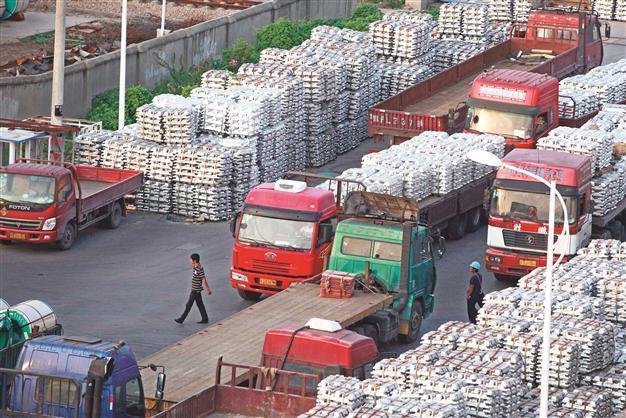China services growth up in August, signaling recovery
BEIJING - Reuters

China’s service sector PMI reached a five-month high in August, according to a survey. The Markit/HSBC Services PMI climbed to 52.8 in August, up from July’s 51.3 and the highest since March. REUTERS Photo
Growth in China's services sector hit a five-month high in August, underpinned by optimism over government policy measures, a private survey showed, the latest evidence that the world's second-largest economy may have avoided a sharp slowdown.The Markit/HSBC Services Purchasing Managers' Index (PMI) climbed to 52.8 in August, up from July's 51.3 and the highest since March, the survey showed on Wednesday. The data came on the heels of three other PMI surveys this week that pointed to a pick-up in activity at factories and service firms.
Investors had as recently as a month ago worried that China's economy was slipping into a deeper-than-expected downturn, especially after its money market was hit by an unprecedented cash crunch in June.
But policymakers have stepped in with a series of measures aimed at stabilising the economy, including quickening railway investment and public housing construction and introducing policies to help smaller companies with financing needs.
"It's still too early to say that the economy has reversed its downward trend, but we have seen some signs of recovery," said Xianfang Ren, senior economist with IHS Global Insight in Beijing.
"Between June and now, the biggest change has been in policy expectations, with China rolling out some steps to boost growth. That has helped business sentiment, hence lifting the PMI readings," Ren said.
Attention now turns to the raft of data for August due from this weekend, with investors looking to figures for trade, industrial output, inflation, money supply and investment to further gauge how the country is faring in its efforts to reverse slowing growth.
Data in July had showed a pick-up in trade and industrial output, while foreign investment into China also quickened, adding to confidence in the economy.
Earlier this week the government's official PMI for manufacturing rose to 51.0 in August from 50.3 in July, the highest level since last April and ahead of market expectations, while the official services PMI was little changed at 53.9 in August versus July's 54.1.
The final Markit/HSBC manufacturing PMI climbed to 50.1 in August, up sharply from July's 47.7. The official surveys are weighted more towards bigger and state-owned companies.
Officials push message
Aside from policy initiatives, senior officials have also been talking up the economy, saying there are clear signs of stabilisation emerging and that the government's annual GDP target of 7.5 percent is achievable.
President Xi Jinping told journalists from four central Asian countries during an official visit that the recent slowdown is by design as the government pushes ahead with its reform agenda.
"China's economy has good fundamentals, and 7.6 percent GDP growth in the first half is already a high rate compared to other countries," he said in remarks reported by state news agency Xinhua.
"But we have chosen to firmly push forward economic structural reforms and pursue a slower growth to address the longer-term issues in the economy.
He added that China has ability to handle its local government debt problem and overcapacity issue in some industries.
However, a number of downside risks remain. Weak exports as overseas demand remains uncertain and a strong yuan currency may weigh on trade -- for example the HSBC PMI showed new export orders for manufacturers dipping from July.
In addition, most Chinese firms still face relatively high financing costs, in part due to Beijing's campaign to curb shadow banking.
Slowing growth has also put pressure on China's heavily indebted companies and provincial governments, raising concerns that the country's explosion in credit since 2008 could be on the verge of a meltdown.
The services industry is an increasingly important pillar in China's economy, especially as the government seeks to expand domestic consumption to drive growth as part of Xi's reforms. Services accounted for about 45 percent of the economy in 2012 and is the biggest employer in China.
Qu Hongbin, an HSBC economist, cited new business growth as the key driver of the index and expected growth momentum of the services sector to be sustained in future.
"A filter-through impact of VAT reform, combined with a rebound in manufacturing output, is expected to support service industry growth in the coming months," Qu said.
Firms in the survey reported that stronger demand and promotions lifted new orders, which rebounded to 53.2 in August and marked the fastest growth rate since March, HSBC said.
Companies also expressed an increased level of optimism towards future output, with the sub-index for business expectations improving to a five-month high.
Average input costs also increased modestly and output charges were raised for the first month in four.
On the downside, employment in the services sector contracted for the first time since April, as service providers saw their profit margins squeezed, HSBC said.
However employment indices in other PMIs had pointed to improvements, indicating that the job situation remains tougher only for the smaller firms covered in the HSBC survey.
















